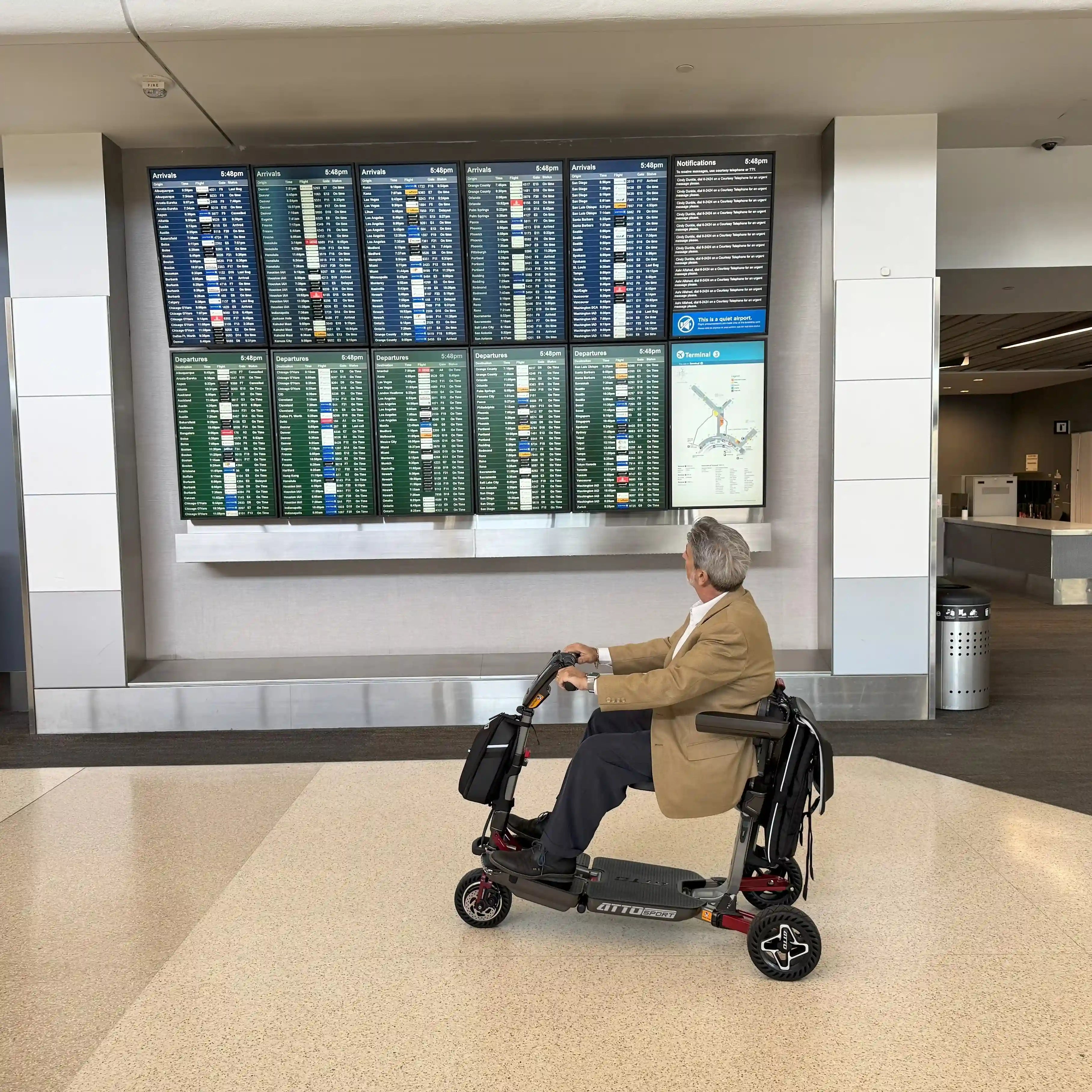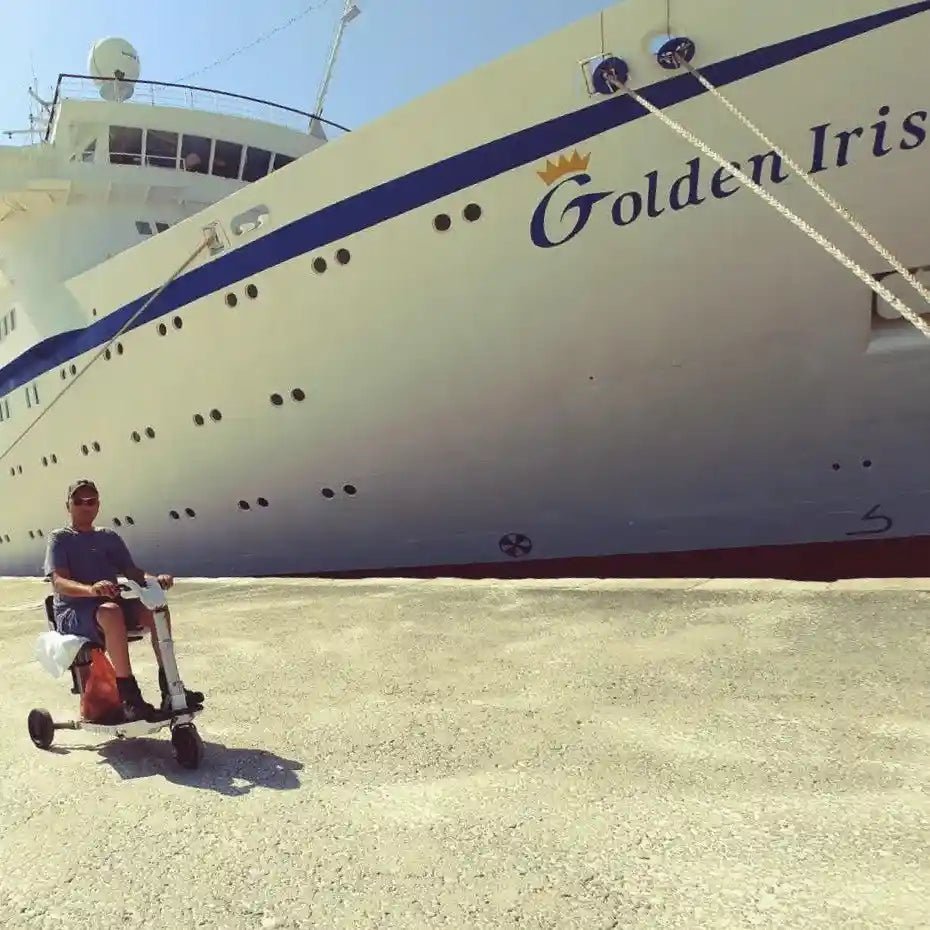The Complete Travel Guide to Airport and Airplane Travel with a Mobility Scooter

You bought a mobility scooter or are looking into buying one, and you want to know if you can use it for air travel. You can, and it is not as difficult as you might think. Preparing beforehand makes travel with a mobility scooter easy and an enjoyable experience.
This guide provides step-by-step instructions for everything you need to know about traveling with an FAA approved scooter for airplane travel. This article covers planning, check-in, TSA procedures, in-flight experiences, and destination procedures for first-time scooter flyers and those who want to update their best practices. The article also examines foldable mobility scooters such as the ATTO, the only folding mobility scooter built for travel.
Plan Ahead
Before booking your flight, it's worth reviewing the airline's policies and requirements. Most airlines are willing to assist, but they need advance notice to ensure everything operates smoothly.
Here are some first steps:
- Contact the airline by phone at least 48 hours before your scheduled flight time. Inform the airline staff about your plan to bring a mobility scooter. This notification period enables airline staff to mark your reservation and set up support for handling your scooter properly.
- Make sure you have the scooter dimensions, weight, and battery specifications available. Airlines need this data to verify your equipment's safety compliance and storage procedures.
- Specifically, ask these questions of the airline: Can passengers use their scooters to reach the gate? When you arrive at your destination, will your scooter be delivered to the gate or with the baggage? Do they assist with boarding or terminal navigation if you need it?
Every airline operates its processes differently, so avoid making assumptions based on past experiences or what others tell you.
Selecting the Proper Scooter Design for Airline Travel
If you plan to fly and travel frequently with a mobility scooter, consider purchasing one specifically made for traveling. Airline staff can handle travel-friendly mobility scooters because they are designed for compactness, lightness, and easy maneuverability.
The ATTO is an excellent example as it is the only folding mobility scooter built for travel. The scooter breaks into two simple parts stored in the overhead compartments of most commercial airplanes, requiring only seconds to fold. The flight-approved battery of this scooter removes the need to guess about airline procedures regarding batteries. The right scooter choice simplifies the entire travel experience.
What You’ll Need at the Airport
You should head directly to the airline counter upon arrival at the airport. The airline staff must know you are traveling with a mobility scooter to provide necessary tags and explain the specific procedures.
You should bring the following items to the airport:
-
You should provide printed or digital documentation that includes your scooter specifications, including battery type and watt-hour rating. A prepared copy of your scooter specifications will help you move through the check-in procedures faster.
-
Documentation for the battery. Airlines must verify that lithium batteries comply with the correct watt-hour safety regulations. The airline allows 300Wh, and it is recommended that you present proof for your flight.
-
The user manual and battery label documentation are backup information for counter staff to understand your scooter's details.
- The scooter must display your name, contact information, and travel destination on an easily visible label or luggage tag. You should use this label to locate your scooter if it gets lost during your journey or needs delivery to a different location.

With most airlines and airports, you should be able to operate your scooter from the airport gate to the airplane door. Your scooter is checked at the gate before the flight and returned to you when you arrive at your destination.
Going Through TSA Security with a Foldable Mobility Scooter
Security screening when traveling with a mobility scooter requires some understanding and patience. Although the process differs from the normal one, it is painless if you remain calm and know what to expect.

Here’s what you can expect:
- Generally, the checkpoint allows passengers to remain seated on their scooters for the entire screening process. The security staff will direct you to inspect at a separate checkpoint without using machines.
- The screening process involves swabbing different parts of the scooter, such as the seat and controls, and potentially inspecting under the seat and battery compartment.
- If you are able to, you may need to walk through a security scanner. If scanning is impossible, they will perform a pat-down inspection while you remain seated in your chair.
- All Lithium-ion batteries must be removed from the scooter before security checks and transported in your carry-on luggage.
Contact TSA Cares by phone in advance to ask about your concerns. The service can help you understand what to anticipate while also setting up on-site support if needed. Having a knowledgeable person by your side makes the experience much easier.
Understanding Battery Rules
Battery regulations make traveling with a mobility scooter challenging, yet understanding the rules and requirements simplifies everything.
Here’s how to stay compliant:
- All aircraft permit lithium-ion batteries may not exceed 300WH. The ATTO foldable scooter and most modern models fall under this safety limit.
- You can place a spare battery in your carry-on luggage provided it meets airline size requirements. The accepted battery configuration includes a 300Wh spare or two 160Wh spares each.
- The scooter battery needs to be removed for airport screening procedures. The battery needs to stay with you inside the passenger area.
- A battery case or electrical tape to wrap the terminals will prevent short-circuiting. This extra step protects against major issues.
Always have the watt-hour rating documentation available along with other relevant information. Providing documentation about the watt-hour rating makes the screening process easier.
Boarding the Plane with a Folding Mobility Scooter for Airline Travel
Using a mobility scooter for boarding does not need to be complicated, provided you clearly explain your situation to the gate staff.

Gate-check the scooter. After reaching the jet bridge, transfer to an aisle chair or walk to your seat. The ground crew will store the scooter in the cargo hold before delivering it to your destination gate.
Bring it on board. You can board with your scooter when it meets size requirements and receives airline clearance for overhead storage.

Before handing over the scooter to staff, you should disable it and remove the key. You should also remove baskets and accessories and confirm the battery stays with you. These minor steps guarantee that everything reaches its destination safely.

During the Flight
You should not operate your scooter during the flight, but some points are worth remembering.
Inform a flight attendant if you need assistance reaching the restroom or exiting the aircraft. The crews of major aircraft provide onboard aisle wheelchairs.
The aircraft battery must go into your carry-on storage for safety and quick access. Your ability to reattach the battery immediately after landing will prevent any delays.
Arrival at Your Destination
Stay seated until your scooter arrives from the cargo hold after the plane touches down. Your scooter will be delivered at the gate or outside the aircraft door.
Even if your scooter fails to appear or gets sent to the wrong area, you should remain calm. Tell a member of the crew or gate agent immediately. If you need help moving around, you can request assistance from a wheelchair escort. Perform a fast visual check of your scooter before departing from the airport. Notify the airport staff immediately if you see any damage to your scooter. Starting the device repair process at the airport provides the best outcome when airlines must fix or replace assistive devices due to damage.
Know Your Rights
The law protects everyone's right to travel with a scooter. The Air Carrier Access Act establishes all requirements that airlines must fulfill for customers with mobility requirements.
- The scooter does not count toward your baggage limits and should not cost to check it at the gate.
- Your rights include getting priority boarding, help during transfer points, and device loading and unloading support.
- The airline must cover scooter repair or replacement costs when your device gets damaged during a flight.
If you experience a major problem, you should contact the Complaints Resolution Official (CRO). Every airline designates an official to handle accessibility problems.

Final Thoughts
Nervousness is natural the first time you travel with a mobility scooter. However, the more you travel, the more automatic it becomes. With proper preparation and a travel-ready mobility scooter, the experience can and will become enjoyable.
Selecting a foldable mobility scooter, such as ATTO, removes many people's concerns about air travel. This device is lightweight and easy to manage while meeting all airline requirements. With proper airline communication and your preparedness, it will be smooth sailing.
Safe travels!
Frequently Asked Questions
Can I ride my mobility scooter to the airplane entrance throughout the entire airport?
Most airlines let you bring your scooter through the terminal and gate-check it at the aircraft door. Your early arrival with gate staff confirmation will secure your smooth travel.
Must I take out the battery pack from my scooter before boarding an aircraft?
Yes, if it’s a lithium-ion battery. For safety purposes, the battery needs to be removed from the device before you pack it in your hand luggage.
Does using my mobility scooter require any additional flight fees?
No. Mobility scooters qualify as assistive devices, and all airlines allow them to travel without additional charges.
What procedures must the airline follow if my scooter gets damaged during the flight?
The law forces airlines to fix or replace assistive devices that become damaged while traveling. Check your scooter immediately upon arrival and inform airport staff about any detected damage.
Can I transport an additional battery for my mobility scooter?
Yes, as long as it meets airline rules. The airline allows one spare battery under 300WH or two spare batteries under 160WH each in carry-on luggage.
Does TSA have special procedures for screening mobility scooters when you travel?
Slightly. Airline security staff will manually search your body and perform tests on your scooter. Plan your visit because the process may take longer.
Does the Federal Aviation Administration allows you to carry a foldable mobility scooter inside the aircraft cabin.
It depends on the size. The ATTO foldable scooter fits in the overhead compartment because it is compact enough, but first, check with your airline about their policies.
- Tags: ATTO Scooter Travel




